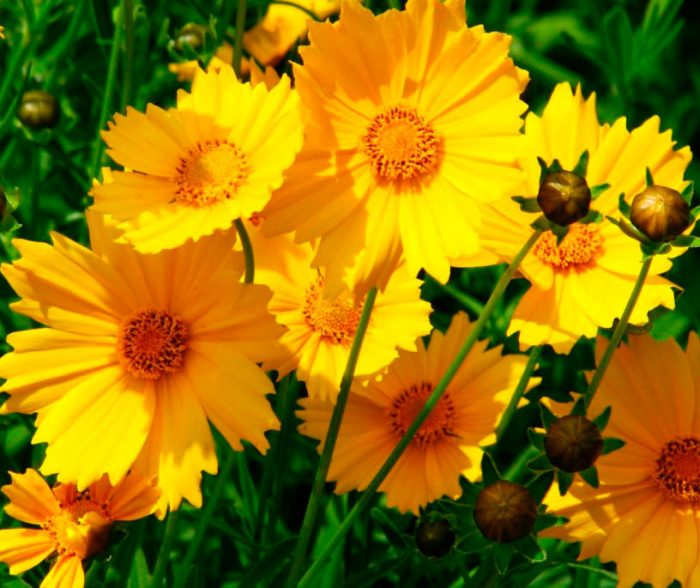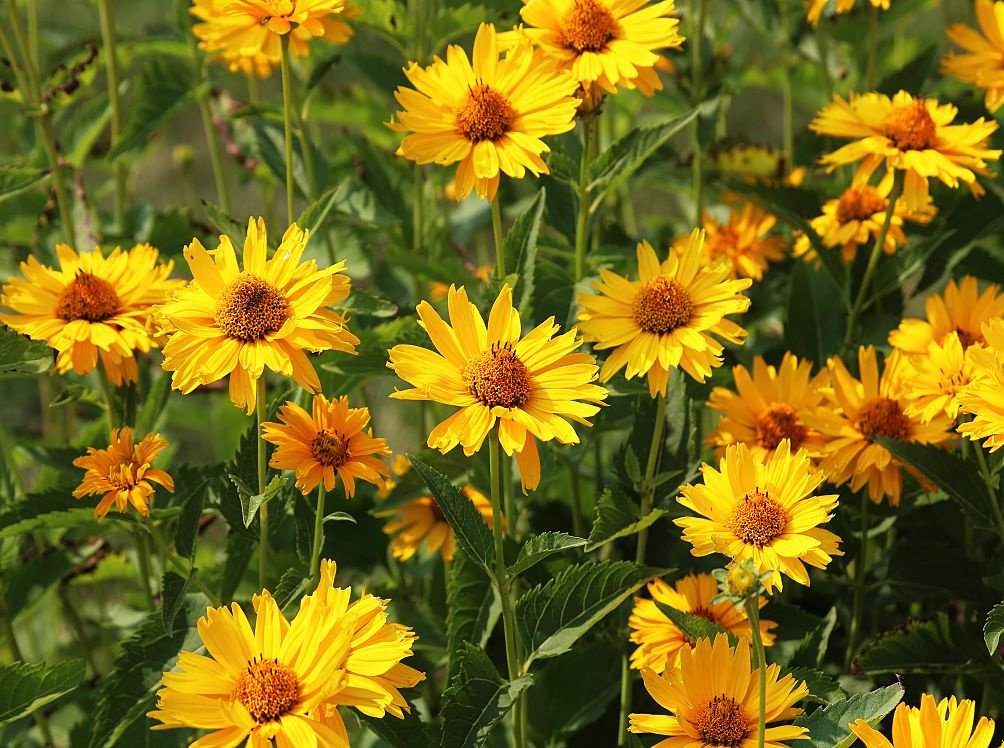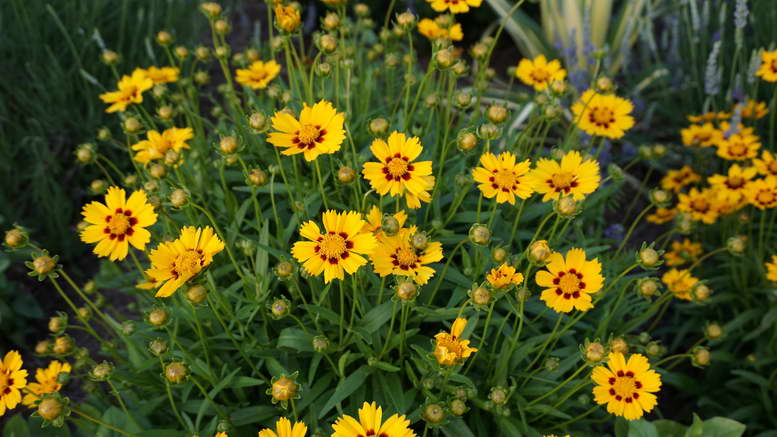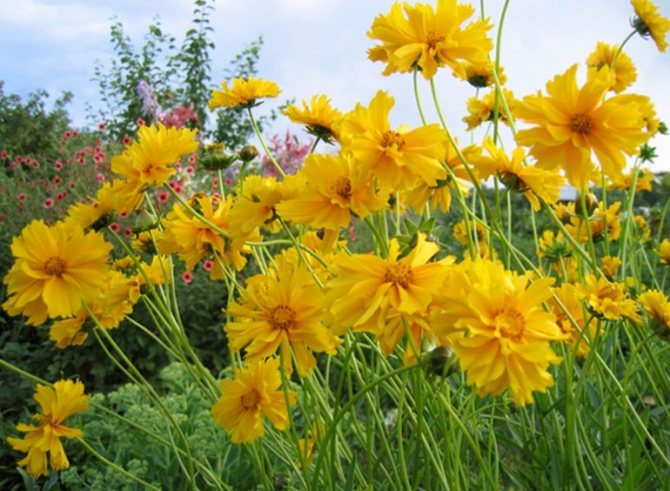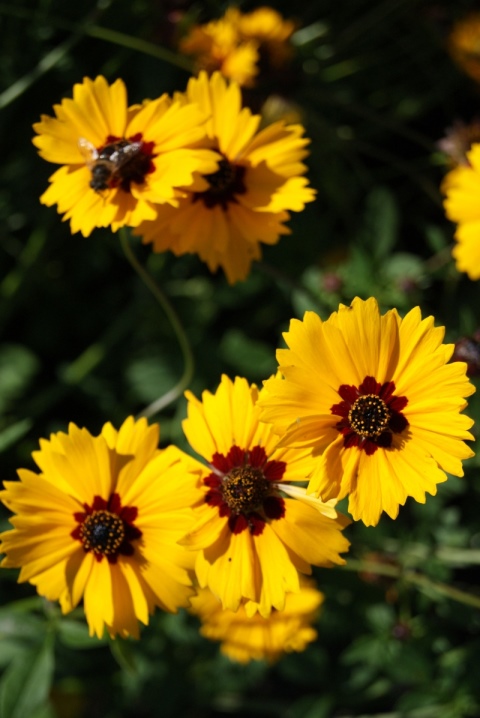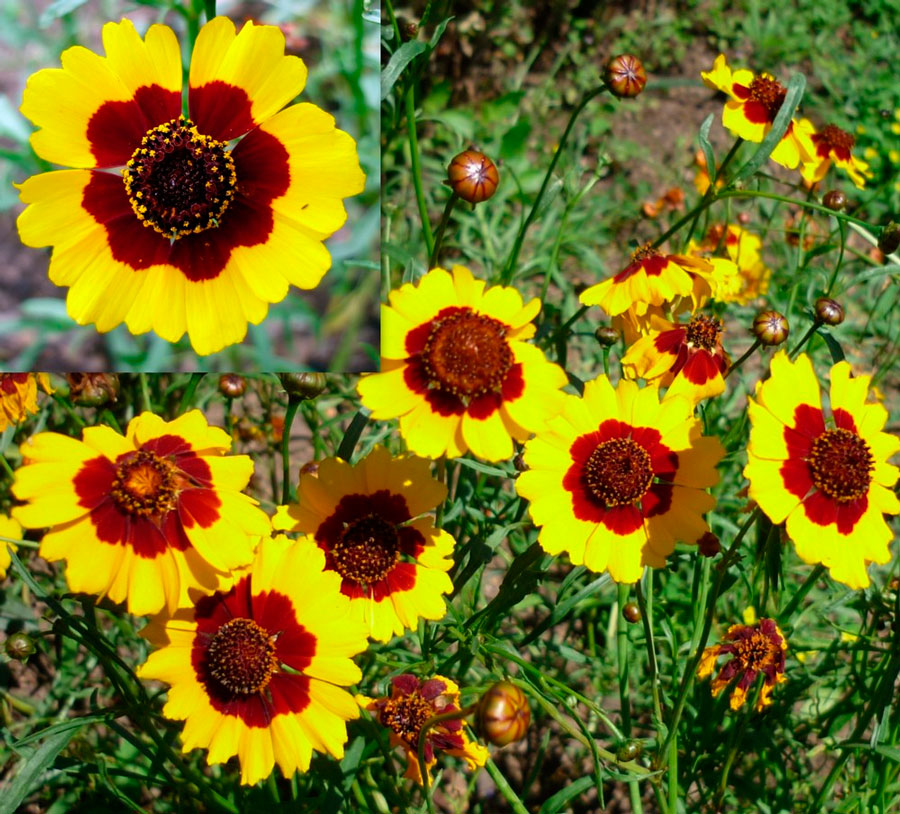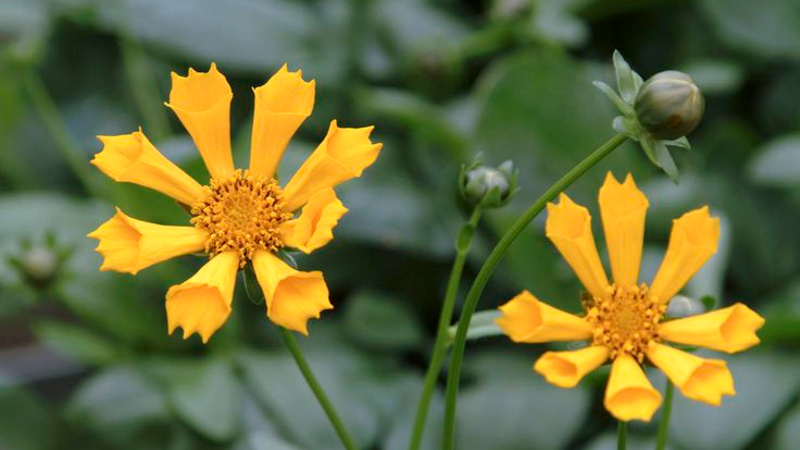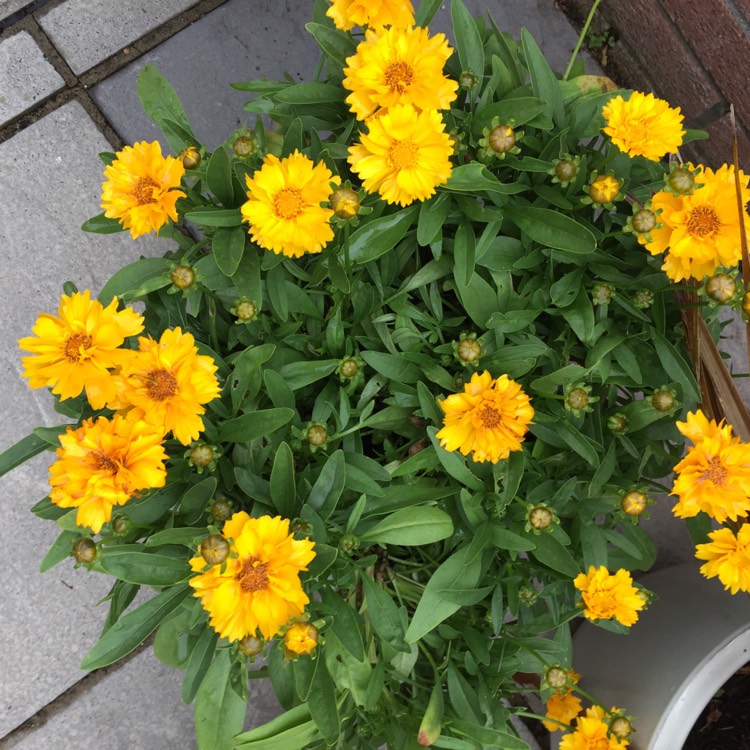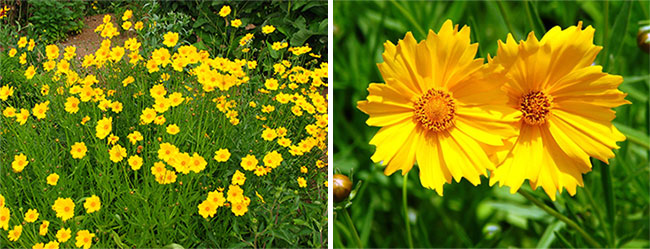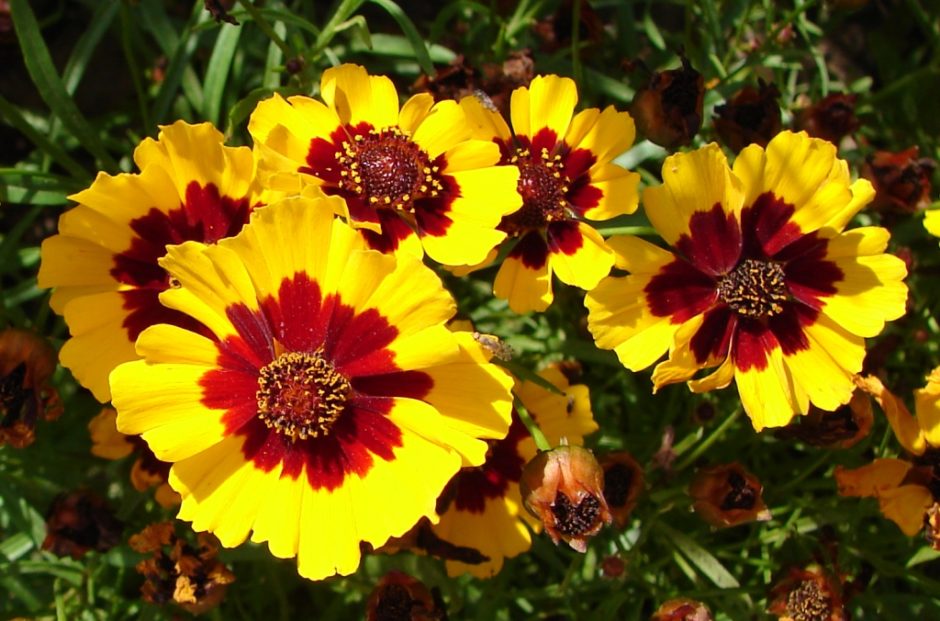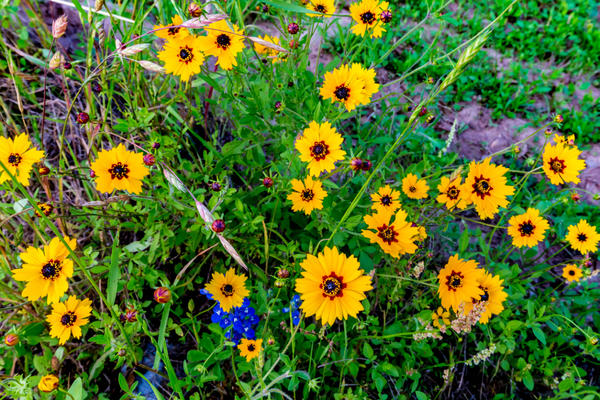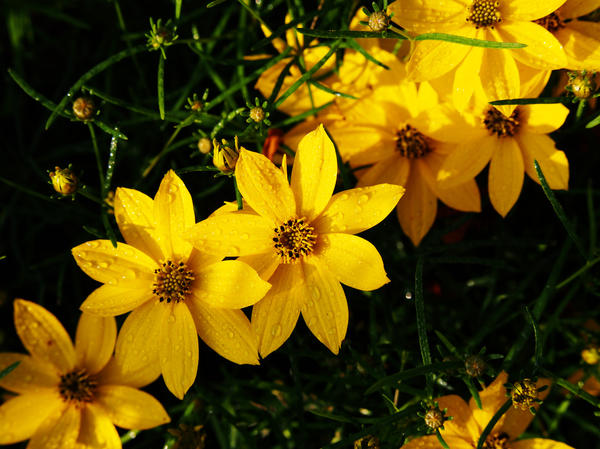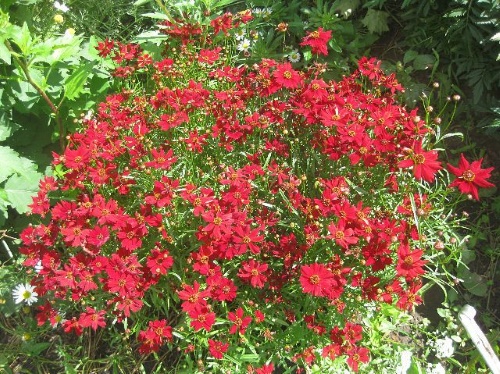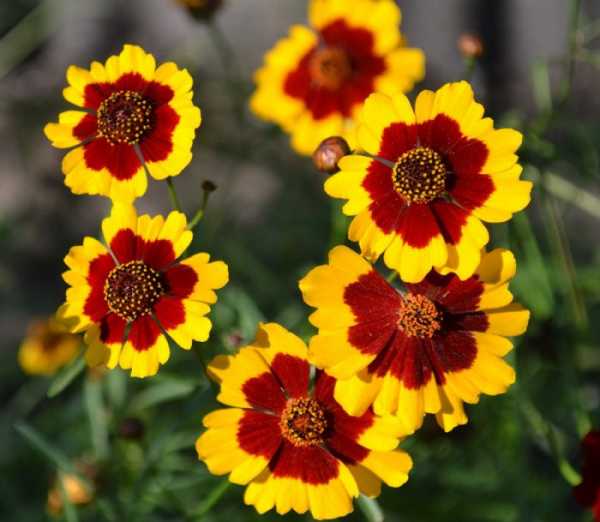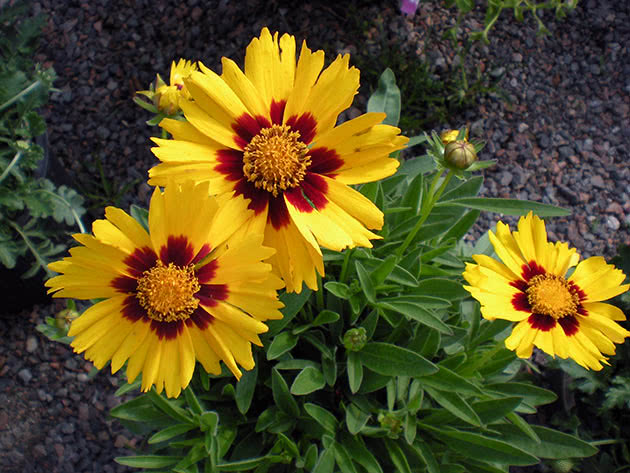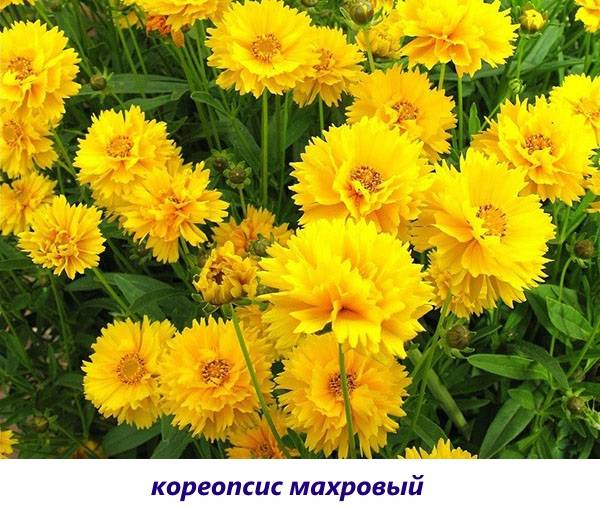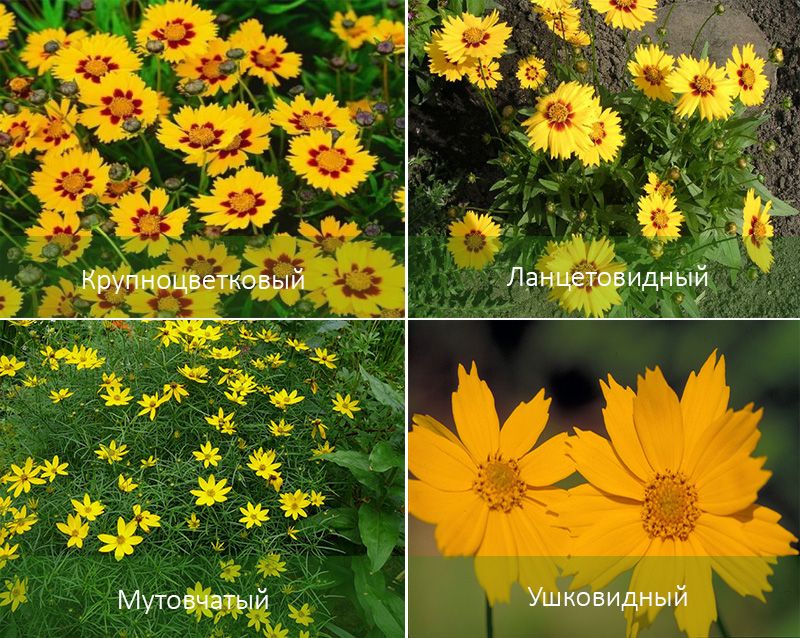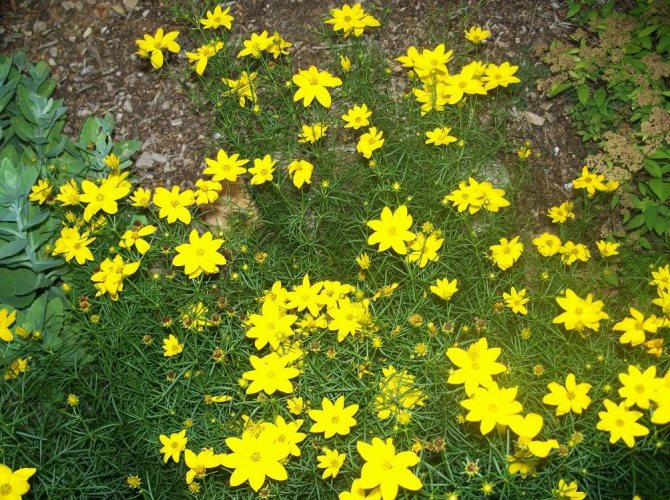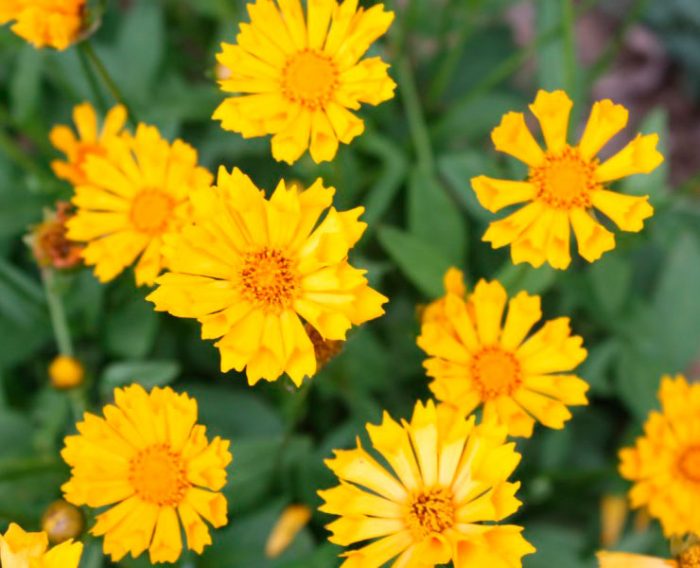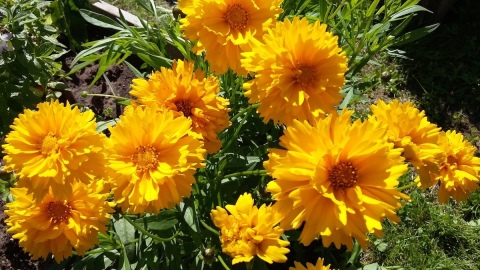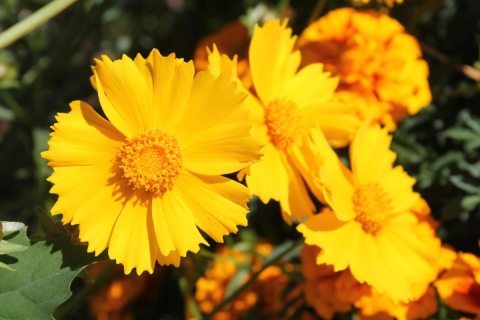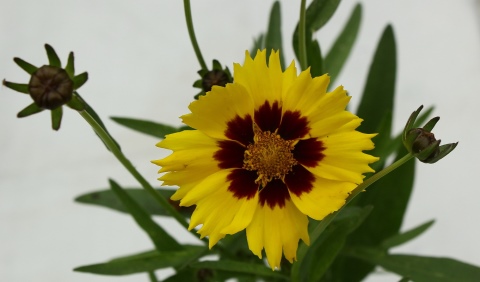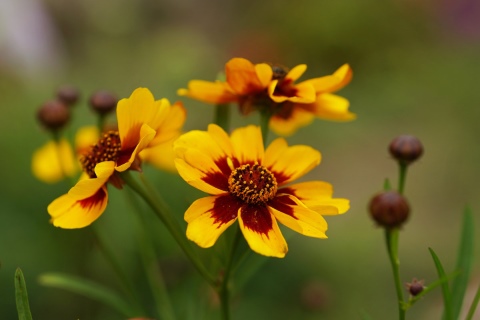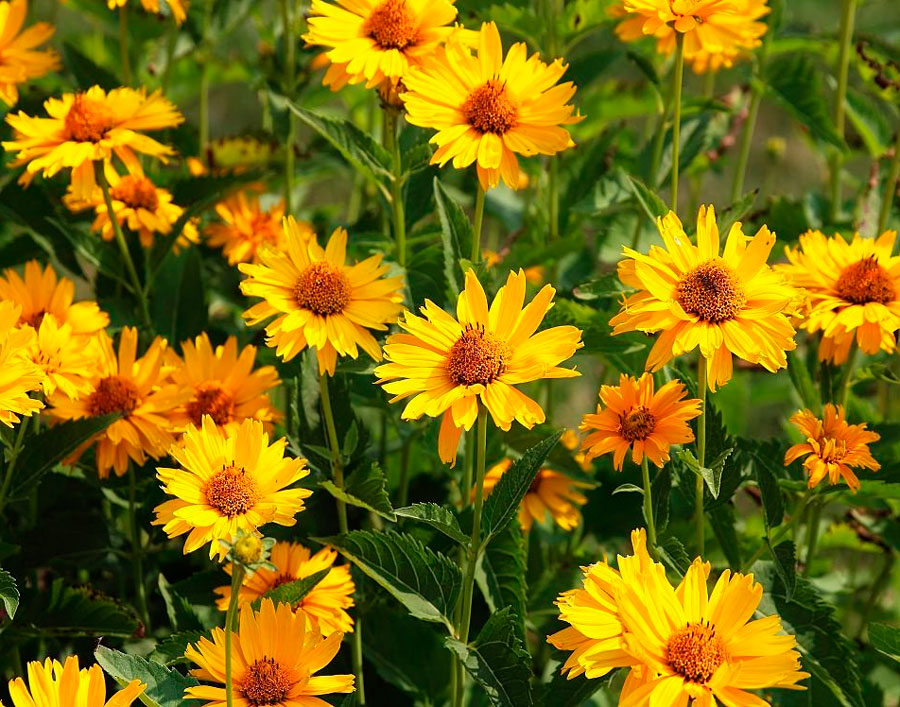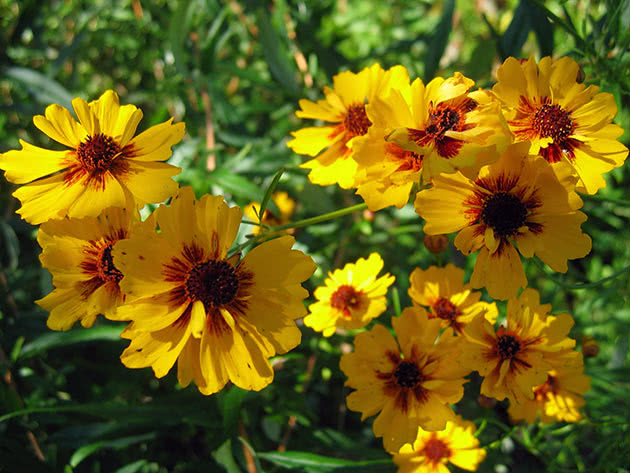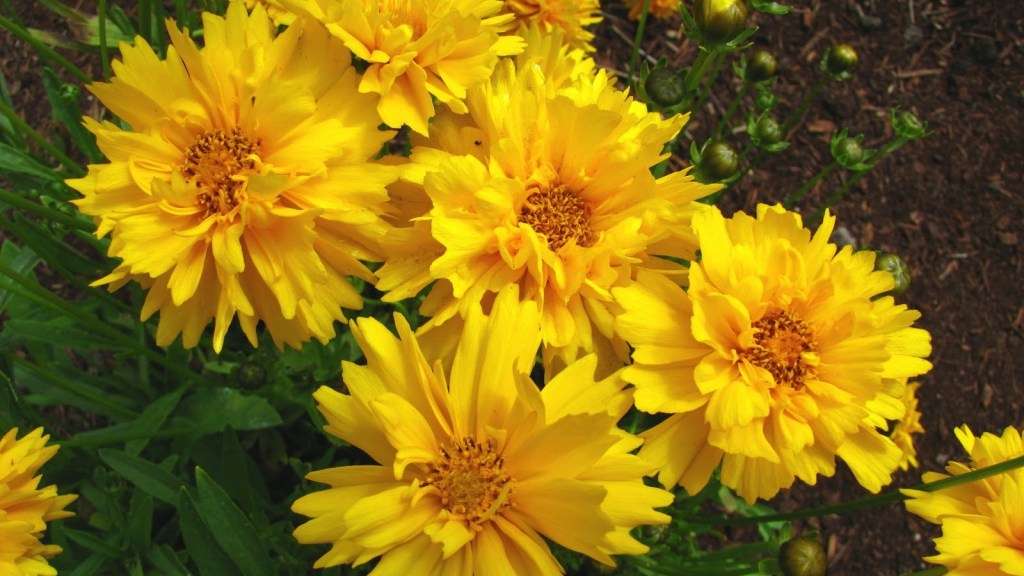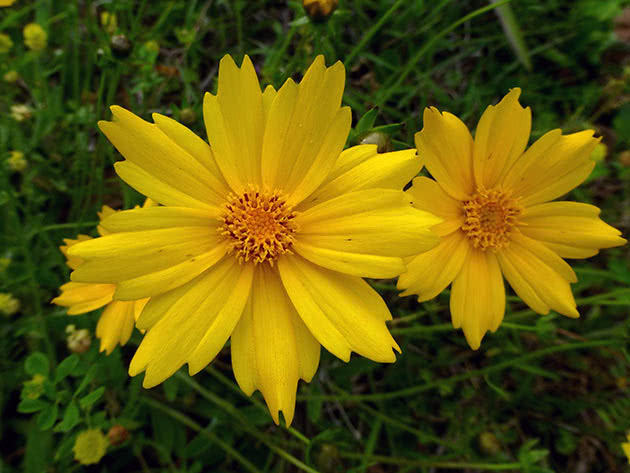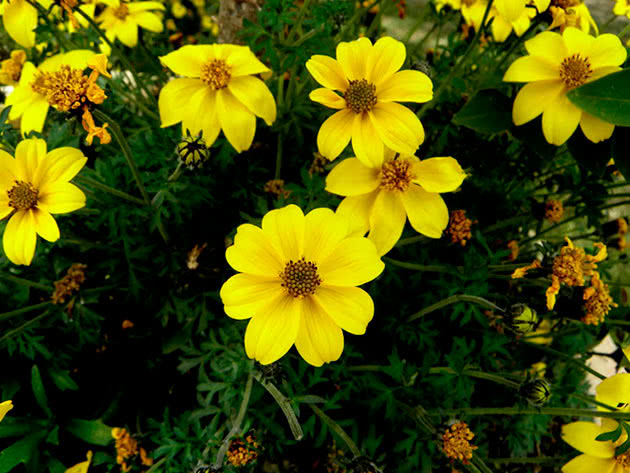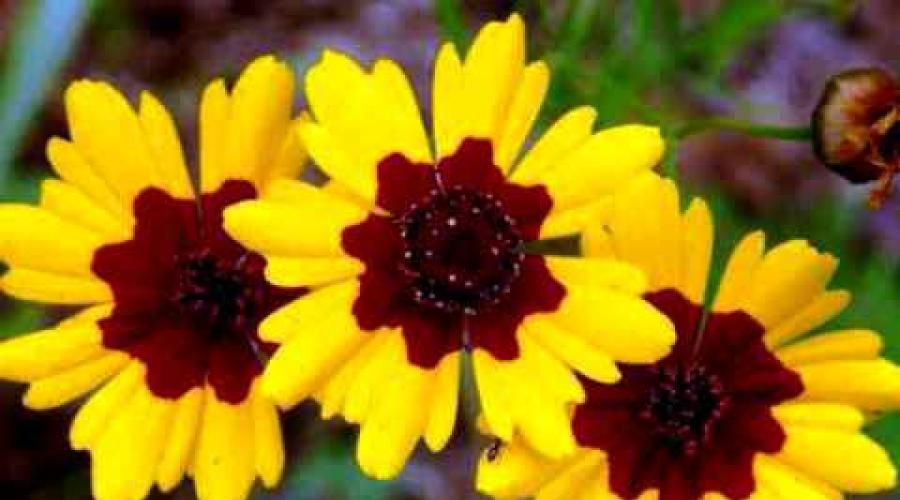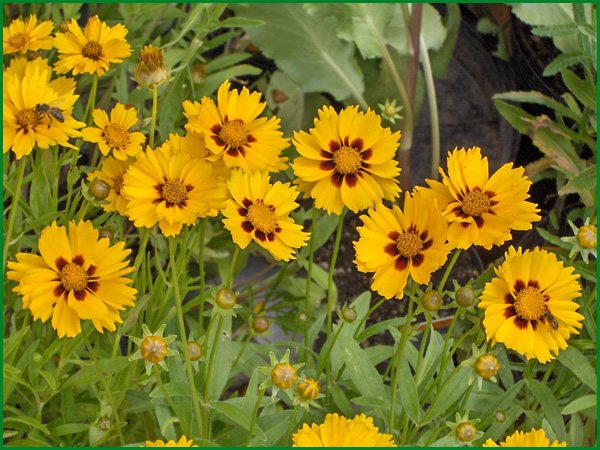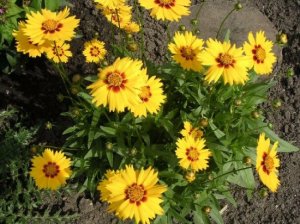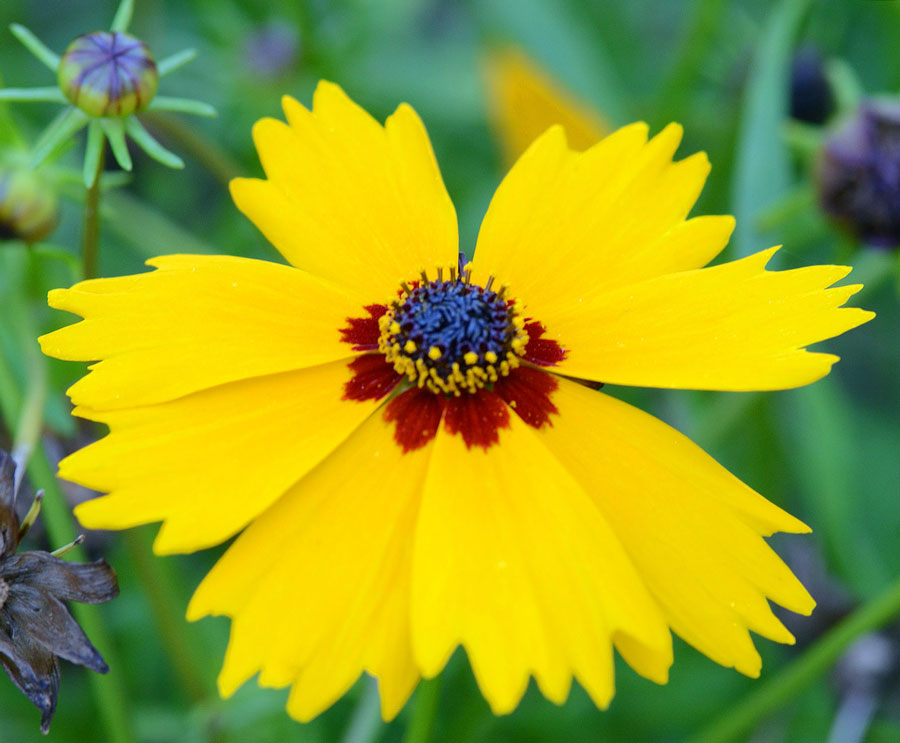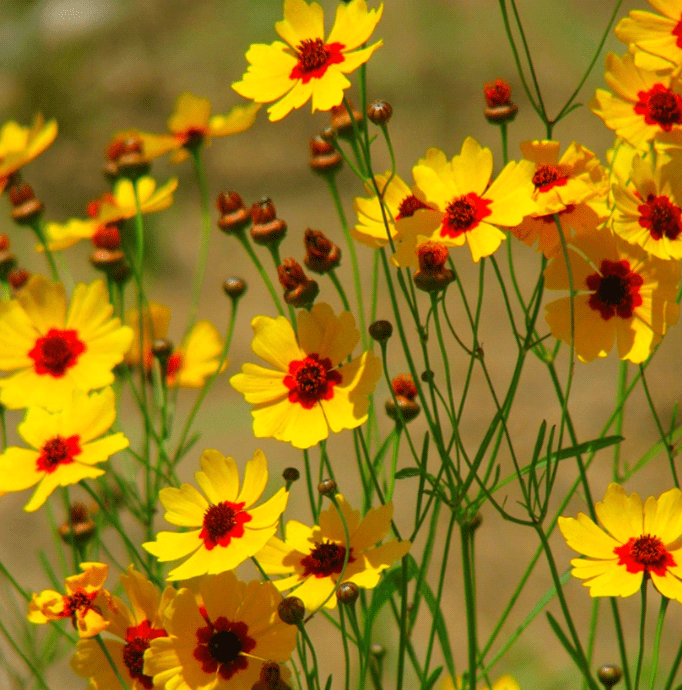Types and varieties
Coreopsis tinctoria - stems are thin and branched. Grows from 30 cm to 1 m high. The leaves are at the bottom. They have a pinnately dissected shape. The inflorescences are solitary, up to 4 cm in diameter. The middle consists of tubular flowers of a dark brown hue, and the petals are arranged in several rows and have a velvety yellow, dark red or golden yellow hue. The most popular varieties of this species, which are grown in culture:
- Goldstral - grows up to 50 cm in length. In the middle, the flowers are dark brown, and at the edges are golden yellow.
- Bluetrot Zwerg - grows up to 25 cm. The middle is dark brown, and the petals are dark red.
- Coreopsis Roll is a variety with crimson flowers with yellow stripes.
- Coreopsis Amulet is a dwarf plant that grows no more than 25 cm in height. The middle is brown, and the petals are red-brown.
Coreopsis ferulele (Bidens ferulifolia = Coreopsis ferulifolia) - is grown in culture very rarely. It grows from 50 cm to 1 m. Leaves are dissected, baskets of a golden hue. The stems are highly branched. Despite its small popularity, this species has several interesting varieties:
- Goldie - the leaves of this variety are slightly shorter, but wider.
- Golden Goddes - the flowers of this variety are much larger.
- Samsara - the bushes of this variety are very compact, therefore they are most often grown in hanging pots.
Coreopsis grandiflora (Coreopsis grandiflora) - the stems of this species are highly branched. The bush grows up to 1 m in height. The upper leaves are pinnately dissected, and the lower leaves are whole. The middle of the baskets is dark yellow, and the petals are golden yellow.
Coreopsis lanceolata (Coreopsis lanceolata) is a highly branched plant. Grows up to 60 cm in height. Leaves are linear or lanceolate. The middle of the flowers is dark yellow, and the petals are golden yellow. Popular varieties of this species:
- Golden Queen - grows up to 60 cm in height. Inflorescences are golden yellow and rather large.
- Goldfink - grows up to 30 cm in height and is considered dwarf.
- Rotkelchen - the middle of this variety is red, and the petals are yellow.
There are many other perennial coreopsis species, but they are not as popular among gardeners and are rarely grown.
Today there are a large number of different varieties and types of coreopsis: terry, yellow, annual, variegated, small-leaved, garden, pink, orange, etc. Consider the main ones.
Roulette. It has double flowers in structure and scarlet in color, which have small yellow and orange blotches. This variety is often grown in various flower beds, as well as in flowerpots in apartments. They should be planted in sunny, well-drained soil.
In addition, such varieties of coreopsis as "Zateya", "Lanslivd", "Incredible", "Golden Ball", "Sunfire", Bengal Tiger, "Bullfinch", "Presto", "Sun Ray", "Bloomsation Chameleon" ...
Dyeing
This species is characterized by a rather thin, but at the same time, having a large number of branching stems, which can reach 1 meter in height. The plant has yellow flowers with a burgundy color in the middle. The flower itself can be up to 50 mm in diameter. It blooms in summer and autumn.
Large-flowered
The name of the species speaks for itself - the plant has a fairly large in size flowers. The bush itself has a spherical shape and can reach one meter in height.
Lanceolate
This type of plant in the wild is found in the United States of America and Canada, as well as in Mexico.
Eared
The height of this type of coreopsis is rather small and the maximum can be 30 cm. Moreover, the flower has short rounded leaves, and it blooms quite early - already in May.
Grassroots
This type of coreopsis is an annual plant. The flowers are colored in a variety of shades of yellow and gold.
Giant
The name of the species is due to the size of the plant. So, in height, coreopsis can reach two meters and exceed human growth.
Other
The whorled coreopsis has a branched stem, which is covered with green leaves that resemble needles in appearance. The flower petals that bloom in July are narrowed in shape.
Pink coreopsis gets its name from its delicate color. This plant is perennial and has needle-shaped green foliage.
2 Landing
Yellow daisies grow best in open sunny areas, and when planted in the shade, they stretch in length and practically do not bloom. Abundant flowering can be observed when planted in loose, fertile, well-drained soil. Sour soil before planting must be limed with dolomite flour or ground chalk. It is advisable to enrich poor soil with organic matter by 20-30 kg of humus or compost for each square meter. If fertilizers were not applied in a timely manner, you will have to increase the amount of fertilizing in the spring-summer period and use complex mineral fertilizers at the rate of 15 -20 g per 10 liters of irrigation water.
Yellow chamomile seeds can be sown directly into open ground, but it is better to grow seedlings and transfer them to the garden after the threat of night frosts has passed:
- For sowing seeds at home, a store-bought mixture for growing flower seedlings is quite suitable.
- Seeds must be sown at the end of March, without burying or sprinkling with earth.
- For seedlings to appear earlier, containers with seeds must be covered with glass and aired daily.
- After 12-15 days, when shoots appear, the mini-greenhouse can be removed.
- For seedlings, it is desirable to provide an air temperature of + 18 ... + 20 ° C and good lighting, as well as keep the soil in a slightly damp state.
- Too dense seedlings should be thinned out, leaving the most powerful and healthy seedlings at a distance of 2 cm from each other.
- When the seedlings grow up to 10-12 cm, they need to dive into separate pots.
- 10-12 days before the planned planting, the seedlings must be taken out into the fresh air, every day increasing the time spent in the open air.
In the middle or end of May, the grown bushes can be planted in a garden bed or in a flower garden, observing the distance between plants 15-30 cm, depending on the size of an adult bush.
Coreopsis seeds can be sown in open ground not only in spring, but also in autumn. During the winter, they will undergo natural stratification and sprout up as strong shoots resistant to unfavorable climatic conditions and diseases.
Diseases and pests
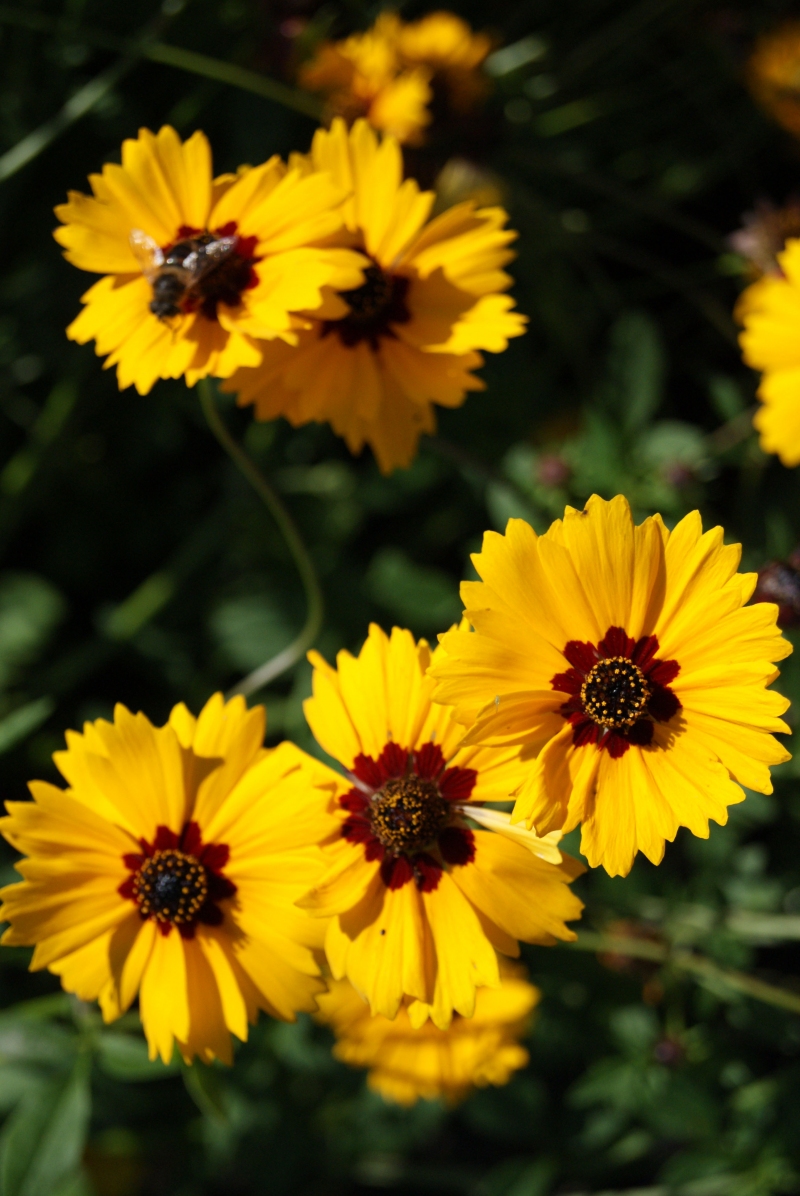
Plants can infect fungal infections due to rainy summers or over-watering. For example, fusarium, rust and various spots. Signs of these infections can be seen on the terrestrial part of the plant. Severely affected plants must be removed from the flower garden, and the rest must be treated with a solution of special fungicides. Such preparations are sold in absolutely any store for florists and gardeners.
As for pests, the plant can be attacked by aphids and beetles. You can get rid of bugs with the help of manual collection, but with aphids, everything is much more complicated. It must be fought with the help of special preparations that must be bred in accordance with the instructions and the plants must be carefully processed.
Among the most dangerous diseases that coreopsis is most often exposed to, the following can be distinguished:
- fusarium;
- rust;
- spotting;
- fungus.
If signs of any of the diseases are found, it is necessary to treat the plant. To do this, the affected areas of coreopsis should be immediately removed, and the entire plant must be treated with fungicides (with intense damage, this procedure is repeated many times).
Reproduction
Any variety of coreopsis can be propagated by seed, but perennial plants can be propagated by dividing the bush. The seed method is used before winter or early spring. Perennial plant species in this case will bloom in the second year of their existence.
And for the early flowering of annual species, it is best to grow seedlings. For this, seeds are sown in early March in a shallow container, which is filled with enriched garden soil. The seed is placed on the surface of the soil, and then pressed into the depths with a plate. The top of the container must be covered with foil, but every day the seeds need moisture and aeration.
After ten days, the first shoots will appear, which you will no longer need to cover with foil. As soon as leaves are formed on the first shoots, they must be planted in separate containers or in one large box.
The distance between the shoots in this case should be two centimeters. A second transplant will be needed when the seedlings reach twelve centimeters. At any stage of growing seedlings, the plant should be watered sparingly, so as not to lead to the disease "black leg".
Before planting on the site, the plant needs hardening, it is taken out outdoors on several hours, and at the end of spring they are planted out of a box into the soil.
For vegetative propagation, in the middle of autumn or early spring, you need to dig out the bush, divide it into parts, in which the formed root and stems are left and immediately planted in the ground on the site. The holes are dug shallow, and the distance between them is kept no more than sixty centimeters. In the same year, the culture will delight with its flowering.
Coreopsis care
A soil of any composition is suitable for a plant, but it is more preferable with good drainage and not too moist. An overly fertile soil is not particularly suitable for a plant, it can stop blooming profusely, and also lose its spectacular appearance. Preferably not too acidic soil.
Shrubs of perennial species quickly lose their attractiveness in a permanent place, so every three or four years it is recommended to divide and transplant to another site. These manipulations are usually carried out in the spring.
Caring for the crop is not difficult, she loves areas with enough light and no drafts. In shaded areas, the stems of the plant stretch more upward while exposing themselves, and the flowering becomes less dense.
Flowers do not require too much watering, they can tolerate dry weather well. Moistening is necessary in the case of cracked soil on the site, but in small quantities, crops with red or pink flowers require more abundant. After watering, the soil is loosened so that a crust does not form on it.
Fertilizers are rarely needed, if the soil on the site is poor. Then, in the middle of spring, once a year, they use complex mineral baits. Organic fertilizers for coreopsis are contraindicated.
Those types of culture that have tall and thin stems, it is advisable to tie up. Otherwise, with gusts of wind, they break. At the end of flowering, the dried flower should be cut off, in which case a new bud may form.
Before wintering, the stems of the plant are cut at the root, but not in large-flowered breeds. They freeze when pruned. It is not necessary to wrap the culture for the frost period, but before the snow cover melts, it is better to make grooves so that the plant is not flooded by spring. But in the northern regions, the bushes must be covered with spruce branches or fallen leaves.
Coreopsis in landscape design
Coreopsis flowers, thanks to their bright and rich shades, are able to perfectly decorate the garden plot. They are planted both separately and among other types of crops. A beautiful combination in a flower bed, when tall plants are planted behind, and lower species in the foreground.
In this case, the flowers on the lower tier hide the translucent stems of the tall ones. Coreopsis can be planted not only in open ground, they look great in flowerpots for decorating a balcony. The culture is also used to decorate bouquets; they can stand in a vase for about two weeks.
Coreopsis diseases
From improper care, the flower can become infected with fusarium, rust or leaf spot. As soon as signs of these diseases are found, the affected parts of the plant are cut off, and the rest are treated with a fungicide. Of the pests for the bush, aphids are dangerous, from which you can save yourself with a soapy solution.
4 planting and care
Planting and growing coreopsis is simple and easy. Annual species can be sown in the greenhouse in mid-April, or they can also be sown in open soil in May. As a rule, in species represented by perennials, the formation of inflorescences is observed only in the next season. However, if you grow them through seedlings, then the bushes will bloom within the first year.

4.1 How and when to plant
Sowing seeds for seedlings is carried out in the first days of March. Low drawers fill with fertile garden soil and moisturize it. The seeds are sown evenly over the surface, gently pressing them into the soil, covered with foil or glass, so that they can then be taken out to a warm, sunny place where there is enough light.
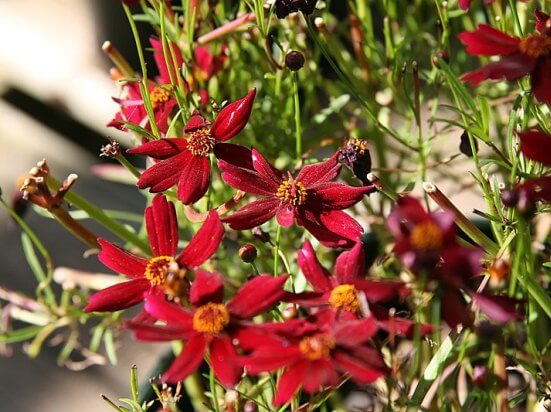
4.2 Soil for coreopsis
Perennial coreopsis are planted in the ground at the end of May. It is desirable that by this time the soil has already warmed up well enough. For better maturation and adaptation of plants, seedlings must be hardened a week before planting in open ground. At the same time, every day she is transferred to the street, gradually increasing the duration of these procedures.
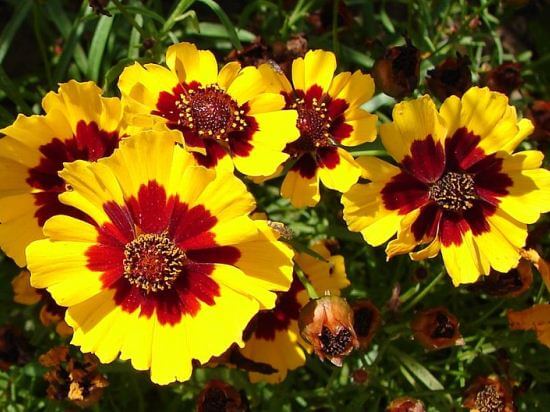
4.3 How to care and prune
Both an experienced florist and a beginner can easily plant coreopsis on their site, providing the plant with the necessary care, timely watering, systematic weeding, and loosening the soil. At the same time, one must not forget to periodically cut off flowers that have already wilted. If you undertook to grow vigorous species of this plant, then it is possible that your bushes may need additional support in the form of an iron rod or a peg, to which you will need to tie it up.
Sometimes, it happens that not everyone in the garden has fertile soil for growing plants and you have to plant flowers in depleted soil. In this case, you can use additional fertilizing in the form of a mineral complex fertilizer. It should be noted that if fertilizer has already been applied to the open ground during digging, then this year the plant is not fed. In the next season, the bushes may need two dressings, which should preferably be carried out after the beginning of flowering, when the plants will be cut in the fall. It is strictly forbidden to cut a large-flowered variety of coreopsis - in this case, it may not survive the winter.
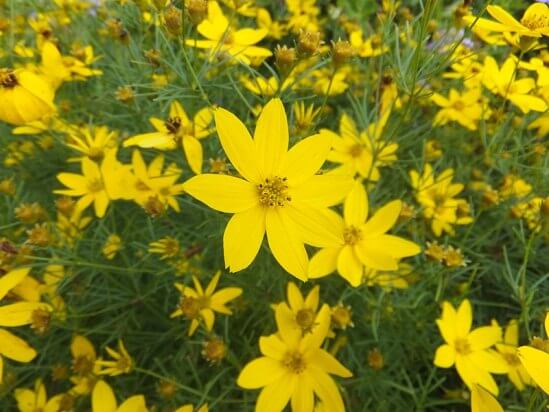
4.4. Watering and feeding
It is necessary to systematically water such a plant only while it is young.
And if it so happened that during the spring and summer it rains periodically, then the bushes can practically not be watered, since adult plants are quite resistant to drought. If there is no rain for several days and the drought becomes prolonged, then coreopsis should be watered regularly. Alternatively, you can use water heated in the sun. Just don't overdo it with too much water. Watering should be moderate, without stagnation of moisture in the soil, because of this, the plant can develop such a fungal disease as black leg, which can be detrimental to the entire bush.
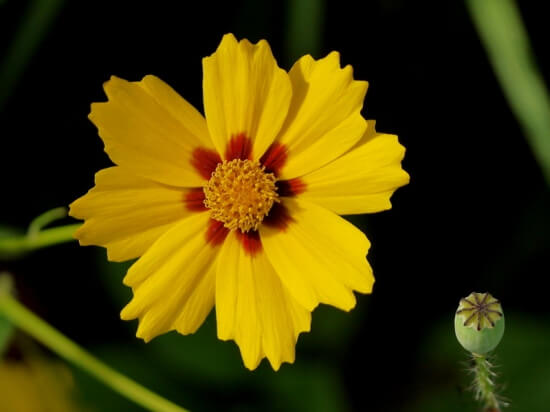
4.5 Coreopsis transplant
It is better not to grow these plants in the same place all the time. They must be transplanted at least once every three to four years. Transplanting will improve the quality of the soil, nourish it with fresh fertilizers and thereby stimulate more abundant flowering. It is best to transplant coreopsis in the spring, dividing the bush into several parts, while the dried and damaged parts must be removed. Then, the coreopsis, along with the earthen lump, is best transplanted into a prepared, well-lit place. It is advisable to add a little sand and fertilizer to the previously made hole.
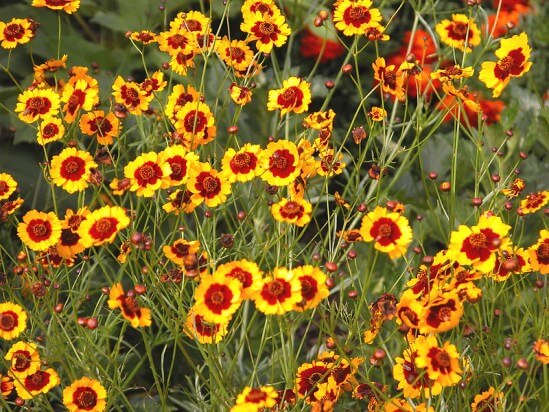
4.6 Preparing for winter
To preserve the rhizomes of the plant during winter, you need to completely cut off the shoots, leaving no more than ten centimeters above the ground. If the winter was not very harsh and snowy, then the coreopsis bushes can not be covered for the winter. However, if there is a risk of frost and a sharp drop in temperature to minus twenty degrees, then the plant will need additional shelter. For such insulation, you can adapt fallen leaves, dry tree branches, coniferous spruce branches or humus
In the springtime, it is important not to forget to remove the shelter so that the root does not overwhelm.

Description of the coreopsis plant
Coreopsis begins to bloom at the end of August and continues into September, filling the garden with beauty and brightness when other flowers have already faded. Coreopsis flowers are bright yellow with a dark center. The petals are dissected, and resemble Gaillardia in appearance.
The name comes from the Latin word forms koris - bug and opsis - species. The plant got this name because of the seeds, which resemble a bug in shape.
There are hundreds of varieties of coreopsis in nature. Most often, flowers grow in America, mainly in a southern tropical climate. This plant is warm and sun-loving. Among the species, there are both perennial and annual flowers.
Coreopsis is a herbaceous flower. Sometimes shrub-like plants are found in the wild.
Types of coreopsis
Coreopsis large-flowered in nature grows in the South of America. This is a bushy plant, the height of which does not exceed 100 cm.
Stems are strong, erect and branched. The lower leaves are oval with a pointed end, and the upper leaves are pinnate, dissected around the perimeter. Inflorescences reach 8 cm in diameter.
Flowers grow on a peduncle one at a time. Flowering begins in July and continues until frost. Large-flowered coreopsis cannot be called durable, since it does not grow in the same place for more than three years.
Popular types of this variety:
- Calypso is a plant with rich yellow buds and a brown center.
- Baden Gold, Sunburst - large, tall plants with massive flowers.
- Sunray are miniature bushes with lush flowers.
- Sandancer is a dwarf subspecies. The height of the bush does not exceed 30 centimeters.

Coreopsis lanceolate is a small shrub with massive branches. Originally from central America. The leaves of the plant are simple, the flowers of the plant are large, yellow, up to 6 cm in size. It blooms for two months, starting in July. Common subspecies of the variety:
- Golden Quinn - yellow buds with a golden sheen, blooming on shoots 60 cm high.
- Rotkellchen is a coreopsis with massive yellow or red buds.
- Goldfink is a short bush with wonderful lemon flowers.

Coreopsis whorled is a shrub with massive, branching stems found in the northern United States. The height of the bush does not exceed one meter.
There are many flowers on the bush, but they are small, resembling a star in appearance. The leaves of the plant are acicular, rich green in color, the petals of the inflorescence are oval with a pointed end. This species has a long life cycle and flowering. Blooms in July and never ceases to delight for 70 days. Common varieties:
- Zagreb is a low plant with golden flowers.
- Moonbeam is a flower with inflorescences of lemon or cream shades. The height of the bush is up to 30 cm.
- Mercury Rising - inflorescences with dark burgundy petals and a bright yellow center. The height of the bush is 40 cm.
- Golden Shower - Golden yellow blossoms on a bush that reaches 60 cm in height. It lends itself well to formation.
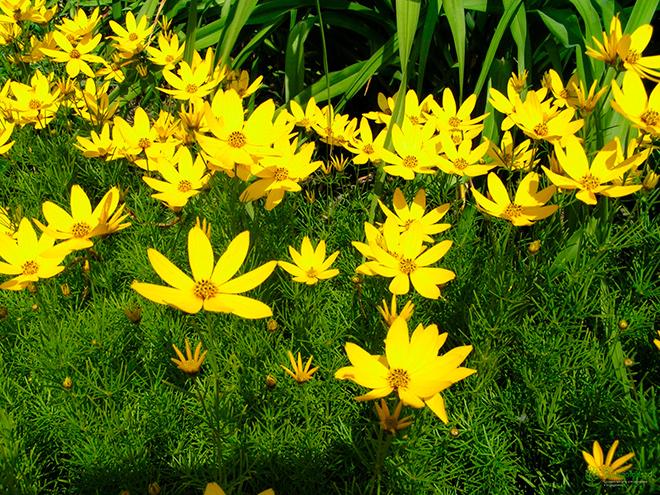
Auricular coreopsis is a dwarf plant native to the eastern United States. Inflorescences are bright yellow, small in size, reminiscent of daisies. If you cut off old inflorescences in time, flowering lasts until frost
Pay attention to the following varieties:
- Nana is a short, lush bush with ellipsoidal leaves. Since the beginning of spring, the plant, like beads, is strewn with small yellow or orange flowers. The second wave of flowering occurs closer to autumn, subject to proper care and a favorable climate.
- Zamfir is a small bush with round leaves and flowers of a sunny golden-orange hue.

Coreopsis pink is a lush, dense, low bush with numerous stems covered with small leaves. The flowers are pink with an amber center, 1–2 centimeters in size. This subspecies has a long flowering period - from early summer to autumn. Plant varieties:
- Sweet Dreams - inflorescences of a delicate malnourish color with white edges. The middle of the flower is yellow.
- Havens Gate is a bush up to 40 cm high with purple inflorescences of extraordinary beauty.
Coreopsis in terrain design
Take a look at the photo of coreopsis and see how beautiful and attractive this flower is. In flower beds and flower beds, these plants often occupy places of honor due to their long flowering period.
Shrubs are planted in the background in a flowerbed from a mix of perennials. Attractive bright yellow buds look attractive with blue, deep blue inflorescences of other plants, for example, with aconites, phlox, veronica and forget-me-nots. Yellow buds look delightful on a green lawn or against a background of tall shrubs.

Recommended species and varieties
All of the plants listed below are perennials. Most of them grow quickly, but usually do not live long, and therefore it is necessary to have new plants to replace the fallen ones every year. Flowering usually lasts all summer.
C. auriculata (K. eared)
The inflorescences are simple, yellow, with ragged edges of reed flowers, appear on this undersized bushy plant in early summer. Leaves are oval or narrow, pointed, sometimes lobed, up to 12 cm long, bright green. The height and diameter of the plant is 50x45 cm.
Inflorescences are simple, yellow
The variety has golden reed flowers.
 Golden flowers
Golden flowers
The flowers are bright yellow, with purple spots at the base of the reeds.
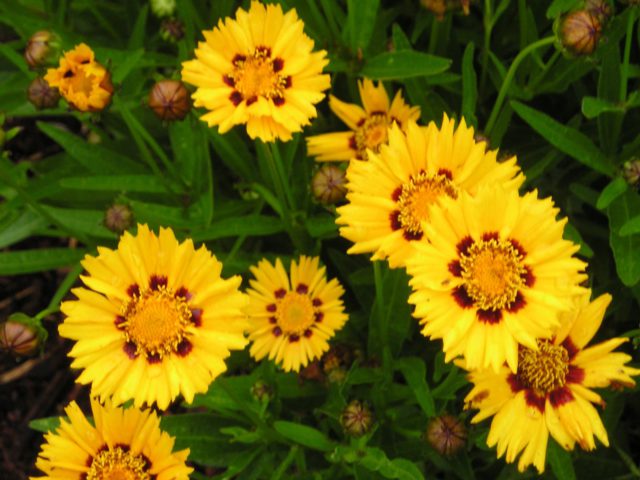 The flowers are bright yellow
The flowers are bright yellow
C. grandiflora (K. large-flowered)
This perennial, often grown as an annual, forms simple yellow inflorescences with ligulate, ragged flowers. Leaves are bright green, belt-like, about 10 cm long, often separated. They form a compact root rosette, height and plant diameter - 60x45 cm.
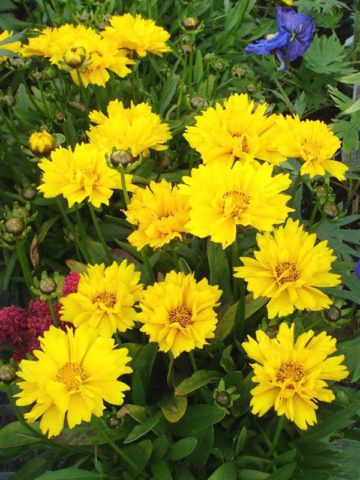 Yellow inflorescences
Yellow inflorescences
Inflorescences are semi-double, golden.
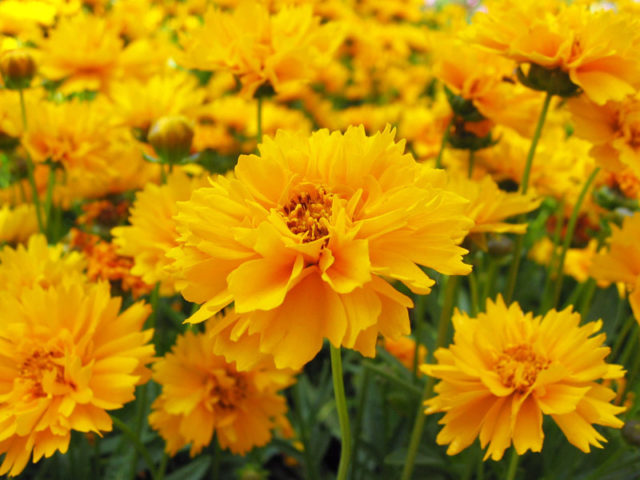 Inflorescences are semi-double, golden
Inflorescences are semi-double, golden
The inflorescences are simple, bright yellow.
Inflorescences are simple, bright yellow
The variety has terry inflorescences, bright yellow.
"Sunray"
C. lanceolata (K. lanceolate)
The inflorescences are simple, bright yellow, up to 6 cm in diameter. Ligulate flowers with ragged edges. Leaves are bright green, up to 15 cm long, forming a basal rosette. To enhance the plant, trim the stems that sometimes appear in summer. The height and diameter of the plant is 45x40 cm.
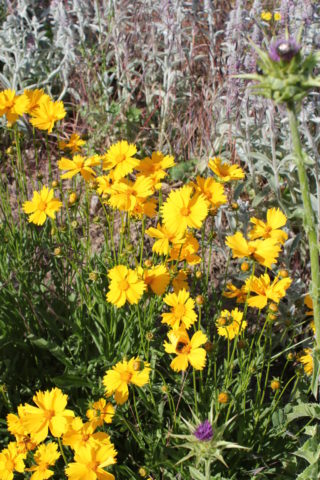 Reed flowers with ragged edges
Reed flowers with ragged edges
The variety is 25 cm high. The inflorescences are simple, golden.
Variety 25 cm high
The variety has golden, simple inflorescences, up to 40 cm high.
 "Sonnenkind"
"Sonnenkind"
Variety up to 75 cm high, terry, yellow inflorescences.
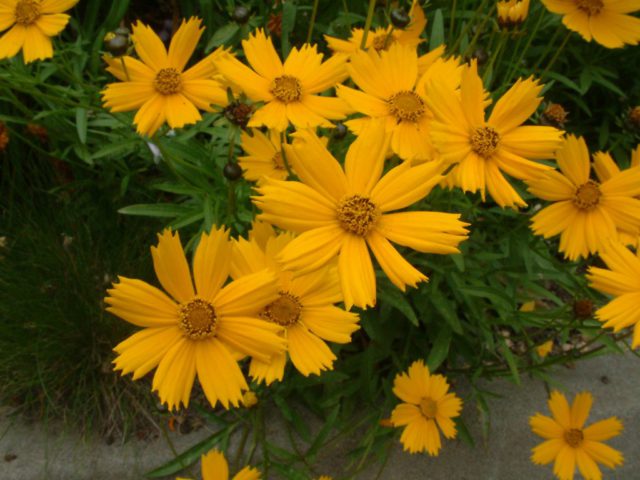 Variety up to 75 cm high
Variety up to 75 cm high
C. rosea (K. pink)
Inflorescences are simple, pink, sometimes white, up to 2.5 cm in diameter. Leaves up to 5 cm long, sometimes with 2-3 lobes. It is a curb plant for planting in the foreground. It spreads through stolons. The height and diameter of the plant is 30-60x30-45 cm.
Inflorescences are simple, pink
Inflorescences are star-shaped, simple, pink.
 Inflorescences are star-shaped, simple
Inflorescences are star-shaped, simple
C. verticitlata (K. verticulate)
During the flowering period, this bushy plant is covered with star-shaped yellow simple inflorescences up to 6 cm in diameter. Leaves are light green, finely divided, like feathers, about 6 cm long. The height and diameter of the plant is 60x45 cm.
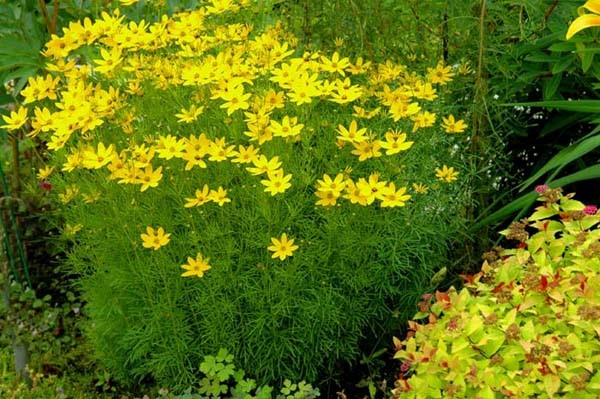 Star flowers
Star flowers
Flowers are yellow;
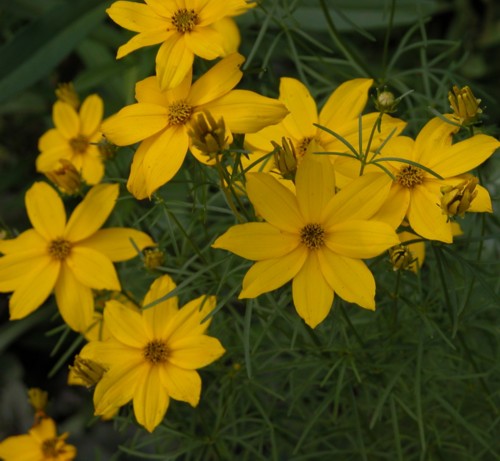 "Golden Shower"
"Golden Shower"
The flowers are golden, 8 cm in diameter;
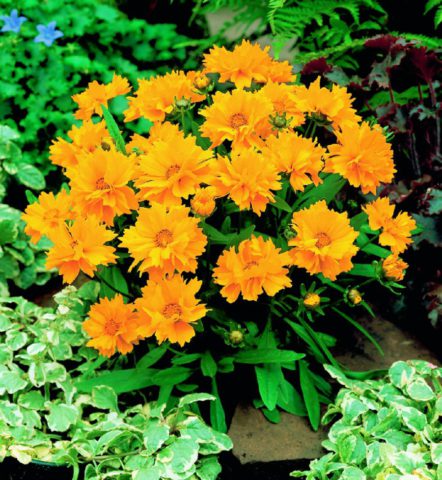 "Grandiflora"
"Grandiflora"
The flowers are light, lemon yellow. This variety is less powerful than other cultivars.
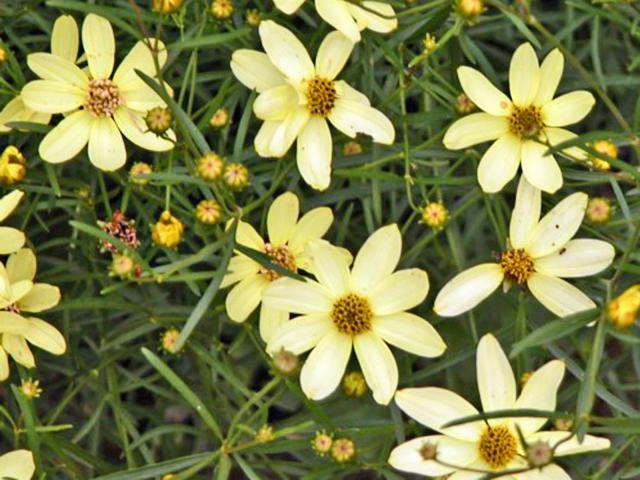 The flowers are light
The flowers are light

